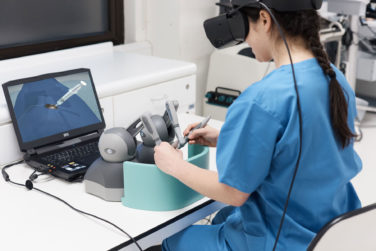Clinical trial protocol writing teams usually start with scientific objectives, and ideally with the goal to help solve an unmet medical need. Historically, this has been a very “academic” and theoretical design methodology, involving literature searches, regulatory intelligence, and market research. All of those inputs still apply and are research sponsor accountabilities. It’s always critical to understand what the standard of care is, the regulatory gold standard to meet, and whether a market (patients, payers, and physicians) will be willing to use the product at the end of the development cycle. However, when designing a patient-centric trial using hybrid methods, some new-to-the-table stakeholders need to be invited in to provide input and offer advice.
The first are the patients who will ultimately agree to test the new product in the trial you’re designing. Not too long ago the pharmaceutical R&D industry thought it was not appropriate to ask patients their opinions, needs, and preferences. Over the past decade, we’ve collectively come to understand the importance of patient feedback; however, patient input is still included too infrequently.
How to Get Useful Patient Feedback for Hybrid Trial Design
Ask patients about their real experience day to day and what they want. Ask them what it’s like to live with the symptoms and disease they are managing every day. Ask them what it’s like to get healthcare, insurance coverage, and the supplies (not the medications) they need to manage their days. Ask them how their families are impacted and who gets involved in decisions about their healthcare. Who would weigh in on whether being in a trial is a good idea? What information would they need to know? Ask all the questions you possibly can about what would be better. What would that look like? What would the ideal situation be like?
Then ask about the trial design you’re thinking about. Is the idea of this new medication or treatment appealing or not? Be sure to explain the expected visits and procedures that are being considered. Would they be willing to join? What would make the trial hard for them? What would make it easier? Is there a trade-off (e.g., some visits in person at a research site and some at home) that could be built into the trial design?
How do they feel about using some of the methods you are considering for the trial? For example, if home nursing visits are a possibility, dig for insights on whether that’s something the patients would like or not, and if not, why not. In other words, get very curious, and invite your patient population to help you design the trial in a way that actually meets what they define as patient centric.
Ideally, the coordinators should be included in those conversations with the patients. That will help everyone understand the patient perspective more deeply, and will make the trade-off decisions easier to agree to as the design is finalized. For example, the patients may be very clear that they are willing to participate but only if some at-home options are included (telehealth, home visits, patient-generated data collection). That may be helpful to site staff to understand if this is not how they would prefer the trial to be conducted.
Utilizing the Knowledge and Experience of Research Site Staff
The other stakeholders who are not often included, and are absolutely essential to making a hybrid trial work are the research site staff. Typically, principal investigators (PIs) and key opinion leaders (KOLs) are asked about the scientific merit of the design and the objectives of the study. But site staff are not the PIs or KOLs; they’re commonly the study coordinators and should be involved in the conversations about the design and how the study will operate at their sites.
Just as for the patients, it’s important to get curious about the site staff’s concerns and what they need to be successful in the trial. That might include feedback about how restrictive the inclusion/exclusion criteria are and the potential impact on recruitment. Maybe it’s about the complexity of the assessments planned and how those assessments will impact both the study staff and the patients if they don’t go smoothly.
It’s essential to ask for as much input as possible about any new technologies or tools that are being considered for the trial. What will it be like to train the research team to use this? What are their concerns about the technology, how long will it take to learn and use, and how will it change their current work practices? Ask very specific questions about what support the study site staff need, their ideal scenarios, and then what they could live with. Realistically, the support solutions put in place are likely to be based on a number of trade-off decisions (complexity, cost, scalability). It’s important to explore the dealbreakers and enablers with the study staff.
What to Know When Executing a Hybrid Trial
Once these dealbreakers and tradeoffs are deeply understood from multiple stakeholder perspectives, the protocol writing team and the study team are well set up to design and execute a truly patient-centric hybrid study. Full-service decentralized clinical trial (DCT) vendors can offer sponsors an à la carte approach to building a hybrid study that includes all of the decentralized components necessary for an optimal hybrid trial. With input from multiple stakeholders, sponsors can select the appropriate hybrid models for each portion of the study and even allow patients the optionality of how they want to participate where applicable. Not only does this allow patients to have a more active role in their trial participation, but this design model also works to ensure that the patient-centric hybrid model is feasible for the site staff as well.
Hybrid trials can offer a unique optionality component to patients. Being able to incorporate patient optionality aspects into any trial can boost patient centricity and patient retention rates. When patients can participate in trials in a way that is easiest and most convenient for them, it can alleviate pain points and improve the patient experience throughout their participation. For example, in some hybrid trial models where a baseline visit with a provider is needed, participating patients can be given the choice to complete these initial visits in person or remotely through a telemedicine option.
Further optionality can be offered to patients with hybrid models that include bring-your-own-device options which allow patients to use their own desktop, tablet, or mobile device to participate in the virtual components of these trials. Both patient and experienced site staff input can help inform where patient optionality would be most beneficial to incorporate in a trial design.
Finally, the study team needs to close the loop on what they decide about both the trial design and the execution plans. Create a way to communicate back to all the stakeholders included in the design-thinking process. Be transparent, not everything that was suggested will be implemented. In order to build both trust and education about the therapy development process it’s important to explain why some things can’t be done or were deprioritized. It’s not hard—but it’s rarely done.









